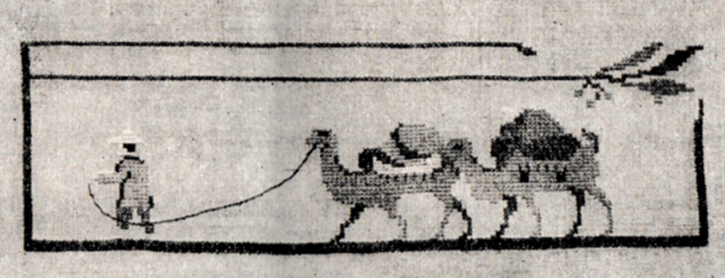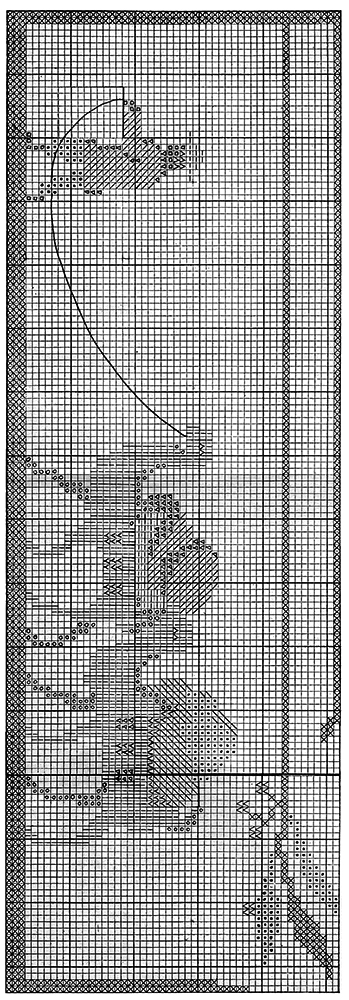Camels - Ships of the Desert Cross Stitch Chart

In these days of transit so very rapid that it quite takes away one's breath even to think of it, the quaint design for runner-ends presented is sure to prove most appealing. Airships which fly from New York to Paris between two days are all very well; we cannot refrain from glorying in such wonderful achievements—we rejoice that we live in this age of marvels. At the same time there is need of a bit of relaxation from the stress and strain of the headlong pace set for us, and we find it in the vogue of needlecraft—simple in style and easy of execution. Truly the slow-moving "ships of the desert" tell a story delightfully different from that of the "miles-a-minute" aircraft, and it is a joy to reproduce it at the point of the needle.
Real Chinese embroidery is perfection itself, so far as regularity and evenness in the placement of stitches are concerned. Especially is this true of cross-stitch, probably the oldest as well as one of the simplest forms of needle- decoration. The stitches are very small, ten or more to the inch, and set with the utmost precision; and there are no knots or ends of threads showing on the wrong side of the work, which is as perfect in appearance as the right side, save that the little upright stitches give a very different effect than the crosses.
Grass-cloth, light tan in tint, makes a most pleasing foundation for the quaint embroidery, and the ends of the runner are finished with a two-inch hem topped by a line of the simplest hemstitching. Everybody knows just how to do cross-stitch, of course; it really seems quite like carrying coals to Newcastle to say more about it. There are, however, two rules which are sometimes overlooked. One is that the same stitch-direction should be observed throughout—must be, indeed, in order to secure the smooth, even effect which is the charm of cross-stitch work; there should also be the same tension. Again, each finished stitch, made by the two crossing threads, should form a perfect square, and there should be no space left between them. The work is done over cross-stitch or Penelope canvas, and is as easy to do as it is fascinating, since the chart, with color-symbols, show just how to place each stitch. Simply baste the canvas evenly on the material and work over it, taking care not to catch your needle into any of its threads; then, when the embroidery is finished, you have only to pull out these threads, one by one, leaving the cross-stitched design as perfect as possible. Work one half of a line of stitches first—from right to left or from left to right, as is most convenient—and returning cross with the second half. This gives a series of neat vertical stitches on the wrong or reverse side, less thread is needed than when each cross is completed at once, and the work is more evenly and quickly done. It is an excellent plan, when several colors are used and rows of stitches are correspondingly short, to have a needle threaded with each color, as used, dropping one when taking another; or, as other workers prefer, to finish with one color before putting in another. So that the two rules suggested are followed, one may safely choose the method by which she attains the best result in the easiest way.
The leading-string is in outline-stitch, done with black, as are the little upright lines attached to the saddlebags. Two strands of embroidery-cotton may be used for working the design with ten cross-stitches to the inch, more in proportion as the size is increased, should this be desired. The work is rapidly developed and very pleasing in effect, the coloring soft and harmonious, and the design unique, hence this latest adventure in cross-stitchery is sure to prove a happy one.


| Pattern Categories Browse the categories to help you find the patterns you're looking for. |
||







